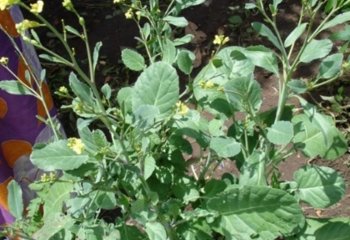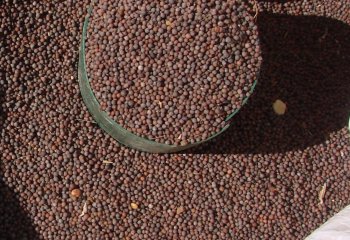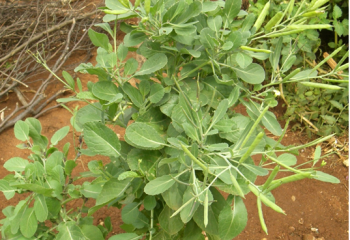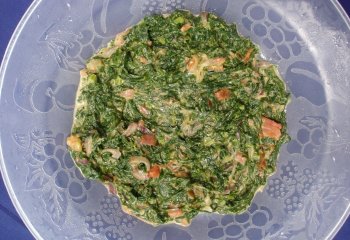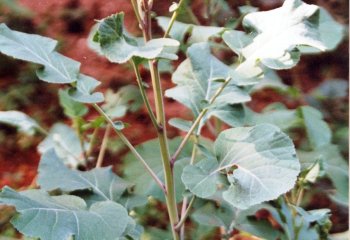Geographical Distribution in Africa
Ethiopian kale is native to Eritrea and Ethiopia. It appears wild occasionally in fild has been introduced in a number of African countries including: Gabon, Ivory Coast, Kenya, Tanzania, Uganda.
© OpenStreetMap contributors, © OpenMapTiles, GBIF
Introduction.
Brassica carinata, also known as Ethiopian kale or Abyssinian mustard, is a member of the Brassicaceae family and the genus brassica. The genus Brassica includes other essential exotic species such as cabbage, turnip, rape and swede, and kales. Ethiopian kale is believed to be native to the Ethiopian Highlands and is the African relative of kale from Europe. It has since spread to other parts of Africa and the world, including South and North America, Europe, and Asia. It is primarily grown in semi-arid regions, where its drought tolerance and short growing season make it an ideal crop.
Ethiopian mustard is cultivated as a multi-purpose crop in the Ethiopian highlands at altitudes between 1500 and 2600 meters. Several landraces exist that are used for their leaves, for their oilseed, as fodder, or a combination of these. Such landraces could be strongly branched with many small leaves, or plants could have just a few branches with larger leaves with a wide range of sizes and shapes in between.
Brassica carinata is a highly versatile plant with numerous applications. In most parts of Africa, B carinata is primarily used as a cooked leafy vegetable. The leaves and the tender stems are eaten in salads, boiled, and pickled. Despite its sharp odor, the cooked leaves have a delightful taste and are abundant in nutrients such as protein, fiber, and vitamins. The plant is often grown in mixtures of other traditional leafy vegetables and is eaten by preparing it with nightshade and spider plant.
Apart from being a food source, B. carinata is also utilized for its medicinal properties. The seeds of this plant are renowned for their efficacy in treating stomach aches, while the water used to boil the leaves is believed to have therapeutic benefits for diarrhea. Moreover, the seeds of ethiopian kale are used as a flavoring spice for raw meat in ethioopia. The seeds also contain glucosinolates that possess anti-carcinogenic properties. B. carinata has significant industrial value, as the oil derived from its seeds can be utilized to produce water repellants, waxes, and polyesters. Although the seeds of this plant contain high levels of erucic acid and glucosinolates, which are unsuitable for human consumption, they are highly productive and serve as a valuable source of animal feed.
(Maundu et al., 1999 ,Grubben et al., 2004, AVRDC & IPGRI, 2006).
|
ⒸMaundu, 2006 |
Ⓒ Patrick Maundu, 2005 |
Geographical Distribution
Brassica carinata is believed to have originated in Ethiopia approximately 4000 years BC, and it boasts a high degree of genetic diversity within this region. However, due to confusion in the literature regarding its distinction from Brassica juncea (L.) Czern., it is difficult to determine the exact distribution of Brassica carinata throughout Africa. The cultivation of Brassica carinata as an oil crop is restricted to Ethiopia, but as a leafy vegetable, it is often grown in East and southern Africa, less so in West and Central Africa (AVRDC & IPGRI, 2006).
Ethiopian kale is native to Eritrea and Ethiopia. It appears wild occasionally in fild has been introduced in a number of African countries including: Gabon, Ivory Coast, Kenya, Tanzania, Uganda.
General information.
Species account
Brassica carinata is an erect, annual herb that grows to a height of 1.2 m or more. The stems and leaves are light green, pinnately lobed, and smaller compared to other brassicas). Flowers are yellow, borne in a long terminal inflorescence. They later bear a long green capsule that turns brown when dried and bears many small, pale to dark brown seeds, 1-1.5 mm in diameter. The time from sowing to the emergence of the Ethiopia kale seedling is about 5 days depending on the temperature and the soil moisture conditions. The plants develop an extensive rooting system. The plant sometimes occurs as a weed in cultivated areas and prefers fertile soils between 0 to 1600 m in elevation that receive 600 mm to 1600 mm of annual rainfall.
(Maundu et al., 1999, AVRDC & IPGRI, 2006)
ⒸMaundu, 2006
Production of Brassica carinata for its seed is important only in Ethiopia. Production in Canada and the Mediterranean region is still experimental. As a leafy vegetable, it is mostly grown as a kitchen garden crop. However, in Tanzania, Malawi, Zambia, and to a lesser extent in Zimbabwe, it is also grown as a market crop. Its use as a leaf crop appears to decline because of higher-yielding leaf cabbage (Brassica oleracea) and leaf mustard (Brassica juncea). No statistical data on its production are known. (AVRDC & IPGRI, 2006).
Ⓒ Patrick Maundu, 2005
Ecological information
Ethiopia kale is adaptable to a variety of environments thriving in highlands of up to 2600m with a cool climate and in lowlands with relatively warm and dry conditions. The vegetable crop does well in wide range of soils except in water-logged or saline soils. It grows best in the dry seasons when there are few pests and diseases. The optimum temperature ranges between 15 and 20 degrees Ethiopian kale' small seeds germinate rapidly in moist soils in partial shade or full sun (AVRDC & IPGRI, 2006
Agronomic aspects
Land preparation
Till land to fine tilth due to B carinata's small seed size. African kale needs to be grown on free-draining soil with good soil fertility – well-decomposed cattle manure should be incorporated into the soil before planting
Seed sources
There are various seed sources for Brassica carinata, including commercial seed suppliers, agricultural research institutions, farmer-saved seeds, and seed exchanges. Commercial seed suppliers offer high-quality genetically pure seeds tested for germination rates and essential traits. Agricultural research institutions offer seed for a nominal fee, and farmer-saved seed is a cost-effective option but may lead to genetic drift. Seed exchanges provide diverse genetic material, but ensuring the seed's quality and viability is essential.
© Maundu, 2011.
Planting
It is advisable to plant on raised beds to reduce the incidences of damping off disease on the vegetable (AVRDC &IPGRI, 2006). Propagation is generally by seeds and rarely through cuttings. Planting is by direct seeding. It may be broadcasting or in rows – 15cm apart. Broadcasting is not encouraged as it results in uneven plant densities and makes it harder to carry out weeding, fertilizer, insecticide application, and harvesting. It is also more wasteful of seed and manure. Farmers may cover the seedbeds with grass to keep the surface moist and dark. When the cotyledons have spread after germination, this mulch is removed or placed next to the plantlets. Seedlings can be transplanted at the 4-leaf stage, about 5 weeks after germination. Depending on the variety, the field spacing is about 35-40 cm within and 50-60 cm between rows. Seedlings are planted with a spacing of about 75x50 cm for varieties with large leaves, as found in West Africa and Tanzania, and 50x50 cm for the small-leaved varieties in Zambia and Zimbabwe. When grown as an oil crop, seeds are sown directly in lines or broadcast when a short-duration leaf crop is aimed for.
© Maundu, 2003
Crop management
Ethiopian kale responds well to manure, and where possible, well-decomposed cattle manure should be incorporated into the soil before planting. Organic matter not only adds nutrients to the soil but also improves the structure of the soil, increasing its water-holding capacity. Manure may be applied at a rate of about ½ - 1kg/m².
A recommended management is to cut the stems at 15 to 20cm height to encourage the proliferation of more and larger leaves. Frequent irrigation is needed for a good leaf yield. When the rains have stopped and irrigation is unavailable, plants will start to flower and produce seeds. When the crop is sown at the onset of the rains, attack by pests and diseases will be severe. To avoid such attacks, it is recommended that the crop be sown 5-6 weeks before rains are expected so that the crop can be transplanted at the onset of the rains.
Harvest, post-harvest practices and markets
a. Harvesting
The first harvest is done while thinning the seedlings from seeds broadcast at high density 6 weeks after sowing. The whole plant is uprooted, especially when the land is needed for another crop. The plants should be about 20cm in height, and thinning should be done to leave a spacing of about 35cm between plants. For a conventional crop, the first harvest takes place about 5 weeks after transplanting. Leaf harvesting is best done once in 2 weeks with 50% defoliation.
b. Post-Harvest
Ethiopia kale leaves are rather perishable – they wilt or become yellow if left on the shelf for more than a day. It is, therefore, advisable to only harvest small quantities at a time. To keep them for a long, leaves are kept moist inside a bag left in the shade or in a cool and dry place. When B.carinata is a whole plant with roots, place the roots in water so they can be kept for a few days. Traditionally, the leaves are dried in the shade for consumption in the dry season. Blanching can also be used to preserve the vegetables. Blanching is done by immersing the vegetable leaves in hot water at a certain temperature for a given period or steaming (Cookbook for traditional vegetables).
Seed Production
To produce a crop for seeds, plants must be selected early and left for late flowering. Large leaves, desirable consumption characteristics, good performance, and disease free are all characteristics to look out for. Such a selection is likely to lead to a significant increase in yields. Seedpods should be protected from birds, which split them open to eat the seeds. Pods should be harvested when fully dry, just before they open naturally, and shatter their seeds. The heads should be plucked off and dried on a large sheet in the shade, not in direct sunshine, as this could result in cooked seeds that will not germinate. Drying completely will usually take 3-5 days. Pods are crushed by hand or hit with a stick to release the seeds, then winnowed to clean them. Seeds should be stored in a clean, sealed container or polythene bag.
Value addition and Market
Brassica carinata is a versatile crop that has attracted attention for its potential as a source of vegetable oil and biofuel. Additionally, the leaves of the plant are a nutritious vegetable, rich in vitamins and minerals and are grown commercially in various countries. In addition to Ethiopia, B. carinata is also grown as a commercial crop in other African countries, including Tanzania, Uganda, Kenya, Malawi, and Zambia.
B. carinata is a highly desirable crop due to its agronomic superiority and ability to withstand frost compared to other oilseed crops and mustards. Additionally, it boasts a high oil content, large seed size, and lower rates of lodging and shattering in comparison to other species within the Brassica family. These favorable characteristics contribute to its overall marketability and potential for success in the agricultural industry.
© Maundu, 2004
Nutritional value and recipes
Brassica carinata is a nutrient dense leafy vegetable rich in vitamins, minerals, and phytochemicals. It is an excellent source of antioxidants, dietary fiber, and protein, and it has been shown to have numerous health benefits.
Ethiopian kale is also a good source of protein, with a protein content of around 25-30% (Mnzava and Schippers, 2007). This makes it an excellent choice for vegetarians and vegans looking for plant-based protein sources. B. carinata is also a good source of vitamins, including vitamin A, thiamin, riboflavin, niacin, and folate. Vitamin A is essential for maintaining healthy vision, skin, and immune function. Thiamin, riboflavin, and niacin are important for energy production and maintaining a healthy nervous system, while folate is necessary for cell growth and development. Furthermore, Brassica carinata has a low glycemic index, which means that it can help regulate blood sugar levels and may be beneficial for people with diabetes.
Table 1: Approximate composition and level of nutrients in raw and cooked Ethiopian kale (Brassica carinata)
|
Kale, Ethiopian (kanzera), leaves, raw |
Kale, Ethiopian (kanzera), leaves, boiled, drained (without salt) |
Kale, Ethiopian (kanzera), leaves, steamed (without salt) |
Recommended daily allowance (approx.) for adults |
|
|
Energy (Kcal) |
0.61 |
1 |
1 |
2300 |
|
Water (g) |
113 |
108 |
99 |
2000-3000c |
|
Protein (g) |
2.7 |
2.6 |
2.4 |
50 |
|
Fat (g) |
90.4 |
90.8 |
91.6 |
<30 (male), <20 (female)b |
|
Carb (g) |
3.3 |
3.1 |
2.8 |
225 -325g |
|
Fibre (g) |
0.6 |
0.6 |
0.5 |
30d |
|
Ash (g) |
0.2 |
0.2 |
0.2 |
|
|
Mineral composition |
|
|
|
|
|
Ca (mg) |
117 |
105 |
96 |
800 |
|
Fe (mg) |
5.7 |
4 |
3.9 |
14 |
|
Mg (mg) |
54 |
31 |
42 |
300 |
|
P (mg) |
51 |
43 |
42 |
800 |
|
K (mg) |
639 |
304 |
472 |
4,700f |
|
Na (mg) |
7 |
5 |
5 |
<2300e |
|
Zn (mg) |
0.7 |
0.48 |
0.52 |
15 |
|
Bioactive compound composition |
|
|
|
|
|
Vit A-RAE (mcg) |
118 |
101 |
92 |
800 |
|
β-carotene equivalent (mcg) |
236 |
203 |
185 |
600 – 1500g |
|
Vit A RE (mg) |
|
|
|
800 |
|
Thiamin (mg) |
1.418 |
1.215 |
1.109 |
1.4 |
|
Riboflavin (mg) |
0.06 |
0.04 |
0.04 |
1.6 |
|
Niacin (mg) |
0.23 |
0.14 |
0.18 |
18 |
|
Vit B12 (mcg) |
0.9 |
0.6 |
0.6 |
3 |
|
Folate (mcg) |
73 |
35 |
38 |
400f |
|
Vit C (mg) |
73 |
35 |
38 |
60 |
Source (Nutrient data): FAO/Government of Kenya. 2018. Kenya Food Composition Tables. Nairobi, 254 pp. http://www.fao.org/3/I9120EN/i9120en.pdf
$ Draining the water several times leaches away water soluble nutrients significantly.
a Lewis, J. 2019. Codex nutrient reference values. Rome. FAO and WHO
b NHS (refers to saturated fat)
c https://www.hsph.harvard.edu/nutritionsource/water/
d British Heart Foundation
e FDA
f NIH
g Mayo Clinic
Complimentary recipes
a. Fried kanzira and leaf amaranth (terere) in fresh milk
Kenyan dish
Ingredients
• 90 g of kanzira (B. carinata)
• 100 g amaranth
• ½ to 1 cup of water
• 1 tablespoonful of cooking fat
• 1 small onion (60 g when)
• 1 medium-sized tomato (40 g when)
• ¼ cup of fresh milk
• Salt to taste (1 pinch)
Preparation
• Remove stalks of the kale
• Wash the vegetables separately, and drain and chop the Kanzira only. You may also chop the amaranth
• Heat the water, add salt, then add the vegetable mixture (blanching). Blanch for 3 minutes. (Blanching is done to retain colour and nutrients). Remove immediately and dip in cold water, then chop
• In a separate saucepan, heat the fat, add the chopped onion and fry it until it turns golden brown. Ensure onions do not burn
• Add the chopped tomato and fry them until tender
• Add the vegetables and stir-fry for five minutes
• Add salt to taste
• Vegetables ready to serve
Variation
½ cup Fresh milk or ¼ cream can be added after frying. Cook briefly after adding milk. It is usually better to add tomatoes to vegetables and avoid cooking tomatoes to retain more heat-sensitive Vitamins.
Remarks
Although this mixture is bitter in taste, all age groups relish it. These vegetables are soft, and their cooking duration is short. This combination is more palatable when fried rather than boiled.
Source; Cookbook for traditional vegetables (IPGRI, 2006).
b. Figiri
(IPGRI, 2006).
Ingredients
• 2 handfuls (150 g) Ethiopian mustard leaves
• One 50 g onion
• 2 (60 g) tomatoes
• 4 tablespoonfuls of cooking oil
• 3 tablespoonful groundnut flour
• ½ cup fresh milk
• Salt to taste
• 1 cup of water
Preparation
• Select the tender leaves of Ethiopian mustard
• Wash in clean running water to remove soil and insects
• Cut the midrib and shred the mustard finely
• Wash, peel, and chop the tomatoes
• Clean, wash and chop the onion
• Fry the onion lightly, add tomatoes, stir and cook till soft
• Add shredded mustard and stir till well mixed. Simmer while covering the pan for 2 minutes
• Mix groundnut flour with milk, add into the vegetables and stir for 2 minutes
• Season to taste and serve as a relish
Variation
• Use coconut milk, water or cream instead of milk
• Use peanut butter instead of groundnuts
• Use meat instead of groundnuts
• Can add carrots to the recipe
Remark
The vegetable cooks fast so do not overcook it.
Source; Cookbook for traditional vegetables (IPGRI, 2006).
Information on Pests.
Cutworms
Description
Cutworm is a greyish hairless worm of waxy appearance. When held in hand, it curls into a little ring of a C-shape. It is usually found in the surrounding area of the cut plant. The cutworms are caterpillars that hide in the soil during the day and only emerge at night to feed young plants or plant parts and cut the young parts on the base.
© Maundu, 2000.
What to do
• Weedy and fields high in organic residue are associated with cutworms; Farm hygiene is one way of controlling the cutworms
• Ploughing the farm helps expose the cutworms to natural predators and sunlight, which eventually kills them
• Nonchemical What to do include flooding the field before the transplanting and physical barriers on small plots of land to prevent the cutworms from feeding on the plants. Examples include the use of protective collars made outbox of paper towels and cups
• Use of pesticides such as Bacillus thuringiensis (Bt).
Cabbage Aphid.
Description
Cabbage aphids, sometimes called mealy aphids, are tiny white bugs that feed on brassica crops in large numbers. Like the common aphid, they feed on the sap of a plant, which means they can do damage to nearly any exposed part of your crop. Cabbage aphids (Brevicoryne brassicae) can severely damage young crops in hot, dry climates.
Symptoms
• -Clusters of the whitish-greyish cabbage aphids on the stems and leaves of the vegetable
-the leaves turn yellow or white, leaf curling will also be seen in plants infested by the cabbage aphids
-stunted growth in plants infested by aphids; their edible heads may appear damaged, stunted, and sticky.
What to do
• Introduction of predators like ladybugs to control the population of the aphids
• -Remove/burn/bury (50 cm deep) heavily infested crops to reduce aphid spread between plants and plots
• Use botanical soap spray to repel and kill aphids: insecticide soap (1 cup of cooking oil with one tablespoon of washing liquid/soap). Apply spray after 20 plants per acre field are infested with small colonies
• -Neem seed powder at 50 g/L water can provide effective control of cabbage aphids with minimal harm on aphid predators such as hoverflies (Syrphids)
Beet Armyworm.
The adult beet armyworm is a grey and brown moth that lays its masses of round, pale-coloured eggs beneath a covering of hairlike fluff collected from its wings. When the newly hatched armyworms emerge, they are usually green and tend to feed in groups, eating away the undersides of leaves. As they mature, their skin becomes smooth and green, and they develop light stripes running along their sides. Typically, they have a black spot on their side above the second leg.
Damage description
-They damage fruits in spring. Larger armyworms feed directly into the berries, while smaller armyworms often feed on the shoulder of the berry beneath the calyx sepals.
What to do
• -Use botanical pesticide (e.g. fresh neem, lemongrass, ginger) 1 litre/15 litres of water
• -Plough a deep ditch. Keep it filled with water. This method is helpful when caterpillars are found to be moving toward your field from the adjacent fields
• -Farm hygiene is essential as a prevention method to protect the vegetables from attack
Information on Diseases.
Alternaria leaf spot (Blackspot, Gray spot)
Symptoms
A -a most common symptom of Alternaria diseases is yellow, dark brown to black circular leaf spots with target-like, concentric rings. Lesion centres may fall out, giving the leaf spots a shot-hole appearance. Individual sites coalesce into large necrotic areas, and leaf drops can occur. Lesions can occur on petioles, stems, flowers, flower pedicels, and seed pods.
What to do
• -Use certified and disease-free seeds; hot water can be used to treat the seeds before planting
• -the practice of long rotations with non-cruciferous crops
• -incorporate diseased plant debris into the soil
• -Farm hygiene is essential in preventing the occurrences of the disease of crops
• -Avoid overhead irrigation
Anthracnose
Description
Anthracnose is a fungal disease caused by different species of Colletotrichum
Symptoms
Leaf symptoms begin as small, pale yellow, or water-soaked lesions rapidly enlarging and turning tan to dark brown or irregular and black. As lesions merge, large leaf areas may appear blighted or entire leaves may die. These lesions soon become sharply sunken and then pinkish in moist weather. Lesions gradually turn green to black and vary from 1/4 inch to 2-1/2 inches in diameter. Anthracnose lesions occur on both green and red pepper fruit. Lesions often have visible concentric rings that are composed of tiny fungal fruiting bodies.
What to do-
• Use of certified seeds, approved seeds, or seeds known to have disease-free history
• -crop-rotation
• -avoid cultivating and harvesting an affected crop when wet to prevent the spread of the fungal spores.
Damping-off
Description
The damping-off disease can occur before or after emergence and typically is associated with wet, cold conditions. Obvious signs are missing plants or wilting of newly-emerged seedlings.
What to do
• Effective control of these diseases involves removing the disease-causing organisms from infected sources. These organisms can be present on gardening tools, containers, in the soil, and even on the seeds before planting. It is important to manage soil conditions and gardening practices to reduce the risk of infection until the seedling has successfully passed its initial stages.
Downy mildew.
Description
The disease is characterized by the emergence of yellow to white patches on the upper surfaces of mature leaves, which are accompanied by white to grayish, cottony fungal growths on the undersides. These downy masses are typically seen after rainfall or heavy dew and usually disappear once the sun comes out. As the disease advances, leaves may become dry and brown and eventually drop off, even if the plant is well-watered.
What to do
• Water the plants in the early morning to allow enough time for drying.
• Prune and remove weeds from the farm to enhance air circulation
• During fall and winter, keep the area under infected plants clean to prevent the spread of disease.
• Whenever possible, select resistant plant varieties.
References
1. African Museums. (2021). Prelude Medicinal Plants Database. https://www.africamuseum.be/en/research/collections_libraries/biology/prelude/browse_plants?g=U
2. Cabi 2021. Cabbage Aphids in the Garden | How to Get Rid of Cabbage Aphids (sympathink.com)
3. Cabi, 2021 Knowledge Bank | Beet Army worm (plantwise.org)
4. N.A. Mnzava & R.R. Schippers. Plant Resources of Tropical Africa 2. Vegetables. PROTA Foundation, Wageningen, Netherlands / Backhuys Publishers, Leiden, Netherlands / CTA, Wageningen, Netherlands. pp.119-123.
5. AVRDC & IPGRI, 2006.African Leafy vegetables. Markets and Gardening practices. Unpublished.
6. Brassica carinata A.Braun in GBIF Secretariat (2021). GBIF Backbone Taxonomy. Checklist dataset https://doi.org/10.15468/39omei accessed via GBIF.org on 2021-12-10.
7. Choudhary Shashi, Sharma Hariom, Arroju Anil, R.t Maruthi,Karmakar Pran (2017).The enus corchorus L.(Malvaceae) in India; Species distribution and ethnobotany.Gentic Resource and Crop evolution.Vl-64.DO.10.1007/s10722-016-0465-1
8. Gebremedhin, G., & Beyene, T. (2018). Ethnobotanical study of medicinal plants in Ganta Afeshum District, Eastern Zone of Tigray, Northern Ethiopia.
9. Grubben. G.J.H & Denton, O, A. (Editors), 2004. Plant resiiurce of Tropical Africa 2. Vegetables. PROTA Foundation, Wageningen, Netherlands/ Backhuys Publisher Leiden Netherlands/ CTA Wageningen Netherlands 668pp.
10. IPGRI 2006.Cookbook for traditional vegetables Unpublished.
11. Latham, P. and Konda ku Mbuta, A.K. (2006) Useful Plants of Bas-Congo Province, Democratic Republic of Congo. 2nd Edition, Mystole Publications, Canterbury, 276.
12. Mnzava, N.A. & Schippers, R.R., 2007. Brassica carinata A.Braun. [Internet] Record from PROTA4U. van der Vossen, H.A.M. & Mkamilo, G.S. (Editors). PROTA (Plant Resources of Tropical Africa / Ressources végétales de l’Afrique tropicale), Wageningen, Netherlands.Accessed 14 March 2023.
13. Mnzava, N.A. & Schippers, R.R., 2007. Brassica carinata A.Braun. [Internet] Record from PROTA4U. van der Vossen, H.A.M. & Mkamilo, G.S. (Editors). PROTA (Plant Resources of Tropical Africa / Ressources végétales de l’Afrique tropicale), Wageningen, Netherlands. <http://www.prota4u.org/search.asp>. Accessed 10 December 2021.
14. Patrick M. Maundu, Grace W. Ngugi, and Christine H.S. Kabuye, Traditional Food Plants of Kenya, Kenya Resource Centre for Indigenous Knowledge, National Museums of Kenya, Nairobi, Kenya, 1999, p. 106.
15. Patrick Maundu, 2007. Malawi vegetable list. Unpublished
16. Patrick Maundu, 2015. Species food list Kamashi, Ethiopia. Unpublished.
17. R.R. Schippers. African Indigenous Vegetables; An Overview of the Cultivated Species. 2002. Revised version on CD-ROM. pp. 42-46.
18. Sympathink. 2021. Cabbage aphids in the Garden.Cabbage Aphids in the Garden | How to Get Rid of Cabbage Aphids (sympathink.com)
19. UF/University of Florida. 2008. CARINATA- Advanced renewables. https://programs.ifas.ufl.edu/carinata/
20. UMASS extension program.(2013) Brassicas, Alternaria Leaf SpotVegetable: Brassicas, Alternaria Leaf Spot | Center for Agriculture, Food, and the Environment at UMass Amherst
21. The University of Illinois Extension.(Extension. ((2021) Anthracnose(Vegetables). Focus on plant problems. Anthracnose [Vegetables] Focus on Plant Problems U of I Extension (Illinois.edu)
22. Lewis, J. 2019. Codex nutrient reference values. Rome. FAO and WHO.
23. U.S. Department of Agriculture and U.S. Department of Health and Human Services. Dietary Guidelines for Americans, 2020-2025. 9th Edition. December 2020. Available at DietaryGuidelines.gov.
Information links
• https://plantvillage.psu.edu/topics/kale/infos/diseases_and_pests_description_uses_propagation
• https://ke.opera.news/ke/en/food/7b0cfe9d8751431bdb305677ec069e6c9.
Contacts information
Simlaw seeds . selling ETHIOPIAN KALE- KANSERA packaged in 10- 500 grams packets. Price range 55-810 Ksh. Contact: (+254)794-546-935. Email: customercare@simlaw.co.ke. Address: SIMLAW HOUSE, Kijabe St, Nairobi City. Web. https://www.simlaw.co.ke/product-details/1835/608
Review Process
Dr. Patrick Maundu, James Kioko, Charei Munene and Monique Hunziker, January 2024

